
Columbia University has developed many traditions over its 270-year-long existence, most of them associated with its oldest undergraduate division, Columbia College.

Columbia University has developed many traditions over its 270-year-long existence, most of them associated with its oldest undergraduate division, Columbia College.
Several traditions take place during the New Student Orientation Program (NSOP) in order to inaugurate new freshmen into the community. During NSOP, students are given time to explore New York City and acquaint themselves with its transportation system. In the First Year March, first-years exit Alfred Lerner Hall through its back doors, turn right and enter campus again through the main gates while being serenaded by staff and administrators to officially become Columbia students. [1] To introduce students to the Columbia Core Curriculum, all Columbia College freshmen attend their first Literature Humanities lecture on the Iliad during NSOP. Students are also gifted a copy of one of the Homeric epics, either the Iliad or the Odyssey , by representatives of the Columbia College Alumni Association. [2]
The Varsity Show is an annual full-length musical written by and for students, and is one of Columbia's oldest traditions. The content of Varsity Shows often satirize many aspects of life at Columbia, including admissions, the Core Curriculum, the university's history, and the administration. Founded in 1894 as a fundraiser for Columbia's athletic teams, past writers and directors have included Columbians Richard Rodgers and Oscar Hammerstein, Lorenz Hart, I.A.L. Diamond, and Herman Wouk. Recent performers have included Jenny Slate, Greta Gerwig, and Kate McKinnon, the latter two both appearing in the 2005 Varsity Show, "The Sound of Muses". [3] The show has one of the largest operating budgets of all university events. [4]
The Columbia University fight song, "Roar, Lion, Roar", written by Corey Ford, Roy Webb, and Morris W. Watkins, originates from the 1923 Varsity Show, Half Moon Inn. [5] Varsity Shows have traditionally featured pony ballets, which prior to the introduction of female performers in 1968, involved cross-dressing. [6]
Your pith in my nails
As I peel you, stinging juice
Squirts into my soul
Dylan Temel,“A Story of Unrequited Love in 5 Haikus" (2018) [7]
Beginning in 1986, the Philolexian Society has hosted this open-to-the-public event in honor of Alfred Joyce Kilmer (Class of 1908), vice president of the society and the author of "Trees". Contestants read their wittiest and worst original poetry, hoping for cheers and the title of Poet Laureate. The event, which regularly draws 200 people or more, generally takes place a week before Thanksgiving. [8] [9]
Morningside Lights is an annual procession through the Columbia campus featuring decorated lanterns made by members of the Morningside Heights community. [10] The tradition began in 2012 as a collaboration between the Columbia University Art Initiative and Miller Theatre. [11] Past themes for Morningside Lights, many of which celebrate Columbia's Upper Manhattan heritage, have included "The Imagined City" (2012), "Odysseus on the A Train" (2014), "TRAVERSE" (2016, celebrating the centennial of the Pulitzer Prize), and "Harlem Night Song" (2020). [12]
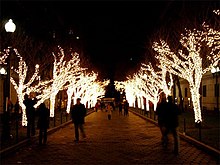
The campus Tree Lighting ceremony was inaugurated in 1998. It celebrates the illumination of the medium-sized trees lining College Walk in front of Kent Hall and Hamilton Hall on the east end and Dodge Hall and Pulitzer Hall on the west, just before finals week in early December. The lights remain on until February 28. Students meet at the sundial for free hot chocolate, performances by a cappella groups, and speeches by the university president and a guest. [13]
Immediately following the College Walk festivities is one of Columbia's older holiday traditions, the lighting of the Yule Log. The Christmas ceremony dates to 1910 under President Nicholas Murray Butler. A troop of students dressed as Continental Army soldiers carry the eponymous log from the sun-dial to the lounge of John Jay Hall, where it is lit amid the singing of seasonal carols. The Christmas ceremony is accompanied by a reading of A Visit From St. Nicholas by Clement Clarke Moore and Yes, Virginia, There is a Santa Claus by Francis Pharcellus Church. [14]
With forty days remaining until graduation, seniors drink 40oz malt liquor on the steps of Low Library to reminisce and celebrate their impending graduation. Regarded as a rite of passage, the event usually leaves debris on the steps and gives passing tour groups a unique impression of the school. The tradition, which began in the early 2000s, has been intermittently sponsored by the administration in an attempt to regulate the event, ostensibly for the sake of student safety. [15]
Student activism has a long history at Columbia, going as far back as students, such as Alexander Hamilton, and student organizations, including the Hearts of Oak militia, fomenting revolution on campus against the British and loyalist members of the administration in the lead-up to the American Revolution. [16] The most notable instance of protest at Columbia took place in 1968, and was widely covered in national media for its entire duration. The Columbia Daily Spectator has noted that Hamilton Hall was occupied by students on ten separate occasions between 1968 and 1996: "Every university has its little traditions—at Columbia, these happen to involve dissent, rebellion, and violent takeover. For those behind the times, a brief history of protest at Columbia, and a word of caution: Steer clear of Hamilton Hall in the spring." [17]
The first commencement at Columbia University was held on June 21, 1758, when the university, then known as King's College, conferred seven degrees upon its first graduating class. Since then, numerous traditions have evolved around the ceremony. Today, the university graduates several thousand students each year from its several undergraduate colleges, graduate schools, and affiliated institutions. [18]
During commencement, students are required to don their academic regalia, and traditionally brandish items representative of their respective schools during the centuries-old ceremony. In addition to "Stand, Columbia," several songs have become associated with commencement at Columbia, including Frank Sinatra's "New York, New York" and Jay-Z's "Empire State of Mind."

The tradition of Orgo Night began in 1975, and was discontinued in 2020 with the dissolution of CUMB. [19] [20] On the day before the Organic Chemistry exam—which is often on the first day of finals—at precisely the stroke of midnight, the Columbia University Marching Band (CUMB) occupied Butler Library to distract diligent students from studying in an attempt to raise the curve on the organic chemistry exam. After a forty-five minutes or so of jokes and music, the procession moved out to the lawn in front of Hartley, Wallach and John Jay residence halls to entertain the residents there. The Band then played at various other locations around Morningside Heights, including the residential quadrangle of Barnard College, where students of the all-women's school, in mock-consternation, rained trash—including notes and course packets—and water balloons upon them from their dormitories above. The Band tended to close their Orgo Night performances before Furnald Hall, known among students as the more studious and reportedly "anti-social" residence hall, where the underclassmen in the Band serenaded the graduating seniors with an entertaining, though vulgar, mock-hymn to Columbia, composed of quips that poke fun at the various stereotypes about the Columbia student body.

There are a number of songs associated with Columbia, most of which date back to the late nineteenth and early twentieth century. These include the university's alma mater and fight song, among others.
"Stand, Columbia" is the Columbia's alma mater. Its lyrics were written by Gilbert Oakley Ward in 1902, and is sung to the tune of Joseph Haydn's "Gott erhalte Franz den Kaiser." [22] [23] It is traditionally played at the university's baccalaureate services and commencements. [24]
"Sans Souci" is the alma mater of Columbia College. Written by Percy Fridenburg around 1888, it was based on a German drinking song, its first two stanzas being translations from the German while the third was an original addition by Fridenburg. [25] [26] Having long served as the entire university's alma mater in an unofficial capacity, it was officially adopted by the college in 1949. [27]
"Roar, Lion, Roar" is the primary fight song for the Columbia Lions. Its lyrics were written by Corey Ford, while the music was composed by Morris W. Watkins and Roy Webb. It was originally written for the 1923 Varsity Show, Half Moon Inn, and is often sung at sporting events. [28]
Columbia University in New York City has an extensive tunnel system underneath its Morningside Heights campus connecting many of its buildings, used by the university as conduits for steam, electricity, telecommunications, and other infrastructure. Throughout their history, the tunnels have also been used for other purposes, mostly centering around transportation. During the first half of the 20th century, they were used by students to avoid aboveground traffic. When the university housed the Manhattan Project, they were allegedly used to move radioactive material between buildings. During the Columbia University protests of 1968, students used the tunnels to facilitate their occupation of buildings on campus.
The West End Bar, also known for a time as the "West End Gate", was located on Broadway near 114th Street in Morningside Heights, Manhattan, New York City. From its establishment in 1911, the bar served as a common gathering place for Columbia University students, faculty and administration. The bar was also a meeting place for many Beat Generation writers as well as many 1960s student activists when they attended the university.

The Columbia University Marching Band (CUMB) was the marching band of Columbia University. Founded in 1904, it claimed to be the first college or university marching band in the United States to convert to a scramble band format, making the switch in the 1950s. Today, all of the Ivy League bands, as well as the Stanford Band, William & Mary Pep Band, and Marching Owl Band have adopted the scramble band style.
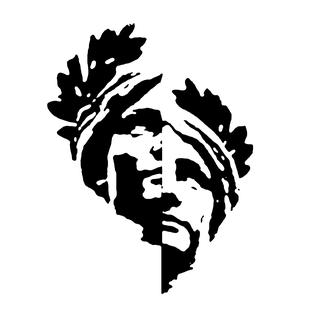
The Varsity Show is one of the oldest traditions at Columbia University. Founded in 1893 as a fundraiser for the university's fledgling athletic teams, the Varsity Show now draws together the entire Columbia undergraduate community for a series of performances every April. Dedicated to producing a unique full-length musical that skewers and satirizes many dubious aspects of life at Columbia, the Varsity Show is written and performed exclusively by university undergraduates. Various renowned playwrights, composers, authors, directors, and actors have contributed to the Varsity Show, either as writers or performers, while students at Columbia, including Richard Rodgers, Oscar Hammerstein II, Lorenz Hart, Herman J. Mankiewicz, I. A. L. Diamond, Herman Wouk, Greta Gerwig, and Kate McKinnon.

John Jay Hall is a 15-story building located on the southeastern extremity of the Morningside Heights campus of Columbia University in New York City, on the northwestern corner of 114th St. and Amsterdam Avenue. Named for Founding Father, The Federalist Papers author, diplomat, and first Chief Justice of the United States Supreme Court John Jay, it was among the last buildings designed by the architectural firm of McKim, Mead & White, which had provided Columbia's original Morningside Heights campus plan, and was finished in 1927.
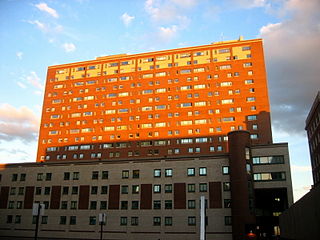
East Campus is a prominent building on the Morningside Heights campus of Columbia University in New York City, located along Morningside Drive between 117th and 118th Streets. One of the tallest buildings in the neighborhood, it serves primarily as a residence hall for Columbia undergraduates, although it also contains a small hotel, the university's Center for Career Education, its Facilities Management office, and the Heyman Center for the Humanities. East Campus, a $28.7 million facility, was designed by Gwathmey Siegel & Associates Architects and built in 1979-1982.

Butler Library is located on the Morningside Heights campus of Columbia University at 535 West 114th Street, in Manhattan, New York City. It is the university's largest single library with over 2 million volumes, as well as one of the largest buildings on the campus. It houses the Columbia University Libraries collections in the humanities, history, social sciences, literature, philosophy, and religion, and the Columbia Rare Book and Manuscript Library.

Alma Mater is a bronze sculpture by Daniel Chester French which is located on the steps of the Low Memorial Library on the campus of Columbia University, in the Morningside Heights neighborhood of Manhattan, New York City. French designed the statue in 1901, and it was installed in September 1903. It is a personification of the alma mater, which represents Columbia in its role as an educational institution; since its installation, the statue has become closely associated with the image of the university.

Hartley Hall was the first official residence hall constructed on the campus of Columbia University's Morningside Heights campus, and houses undergraduate students from Columbia College as well as the Fu Foundation School of Engineering and Applied Science. The building is named for Columbia alumnus Marcellus Hartley Dodge, who donated $300,000 for its construction shortly after his graduation. The building was meant as a memorial to his grandfather, Marcellus Hartley, the owner of Remington Arms, who died during Dodge's sophomore year and who bequeathed him the family fortune. Dodge hoped to create “the commencement of a true dormitory system" at Columbia.
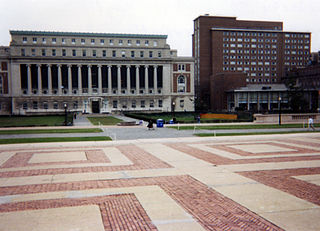
Carman Hall is a dormitory located on Columbia University's Morningside Heights campus and currently houses first-year students from Columbia College as well as the Fu Foundation School of Engineering and Applied Science.
"Roar, Lion, Roar" is the primary fight song of Columbia University. It was originally titled "Bold Buccaneers" and was written with different lyrics for the 1923 Varsity Show Half Moon Inn by Columbia undergraduates Corey Ford and Morris W. Watkins, and alumnus Roy Webb. In order to compete in the Columbia Alumni Federation's contest to find a school fight song the same year, Ford wrote a new set of lyrics that would become "Roar, Lion, Roar". The title references Columbia's mascot, the Columbia Lion.

Postcrypt Coffeehouse is an all-acoustic music venue in the basement of St. Paul's Chapel at Columbia University in New York City, run completely by students. Founded in 1964, Postcrypt has hosted many up-and-coming folk musicians, including Jeff Buckley, Dar Williams, Shawn Colvin, David Bromberg, and Ani DiFranco. Additionally, Suzanne Vega, a graduate of Barnard College, returns to Postcrypt each Spring to play one secret concert. The young folk singer Anthony da Costa performs there regularly, and Mary Lee Kortes, of the band Mary Lee's Corvette, has played there along with her husband, the guitarist and producer Eric Ambel.
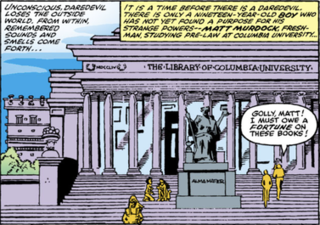
Columbia University in New York City, New York, as one of the oldest universities in the United States, has been the subject of numerous aspects of popular culture. Film historian Rob King explains that the university's popularity with filmmakers has to do with its being one of the few colleges with a physical campus located in New York City, and its neoclassical architecture, which "aestheticizes America’s intellectual history," making Columbia an ideal shooting location and setting for productions that involve urban universities. Additionally, campus monuments such as Alma Mater and the university's copy of The Thinker have come to symbolize academic reflection and university prestige in popular culture. Room 309 in Havemeyer Hall has been described as the most filmed college classroom in the United States.
Bwog is an independent, student-run news website geared toward members of the Columbia University community. The website provides news, features, and commentary on issues affecting Barnard, Columbia, and Morningside Heights, Manhattan.
The 2021–2022 Columbia University strike was a labor strike involving graduate student workers at Columbia University in New York City. The strike began on March 15, 2021, and ended on May 13, 2021. However, additional strike action commenced on November 3 and lasted until January 7, 2022, when a tentative agreement with the university was reached. The strike was organized by the Graduate Workers of Columbia–United Auto Workers Local 2110 (SWC–UAW), a labor union representing student workers at the university. The goals of the strike were an increase in wages, increased healthcare and childcare coverage, and third-party arbitration in cases of discrimination and sexual harassment.
"Stand, Columbia" is the official alma mater of Columbia University in New York City, New York. It was written in Gilbert Oakley Ward for the university's 1902 Class Day ceremonies, and is sung to the tune of Joseph Haydn's "Gott erhalte Franz den Kaiser", which served as the melody for the Austrian national anthem until 1938, and was adopted as the German national anthem in 1922. The hymn is traditionally played at the university's baccalaureate services and commencements.
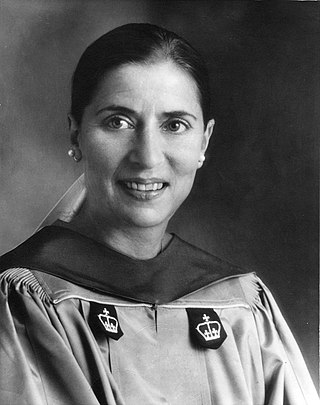
The academic regalia of Columbia University are the robes, gowns, and hoods which are prescribed by the university for its graduates. As one of the oldest universities in the United States, Columbia University has a long tradition of academic dress dating back to its founding in the 18th century, when it became the second university in the country to formally adopt academic robes. The development of Columbia's academic regalia has strongly influenced those of most universities in the United States. Since the passing of the Intercollegiate Code of Academic Costume in 1895, the style of academic dress worn at the university in the late 20th century has served as the basis of those of most other universities in the country. Though once worn daily by students at the university, caps and gowns now are only worn during commencement.

Roar-ee the Lion is the current incarnation of the Columbia Lion, the official mascot of Columbia University and the Columbia Lions. Already a long established symbol of the university, it was first adopted as the university's mascot in 1910 under the name "Leo Columbiae", and was renamed Roar-ee the Lion in 2005. Throughout its history, the Lion has been represented by live specimens on several occasions, including the 1934 Rose Bowl and a 1963 football game against Princeton. During the early 20th century, Matilda the Harlem Goat was an unofficial mascot for the university. Barnard College possesses its own mascot, the Barnard Bear.
Nutellagate was a controversy at Columbia University surrounding allegations of widespread student theft of dining hall Nutella. Columbia first began serving Nutella in its dining halls in February 2013. Within a month, future Pulitzer Prize winner Cecilia Reyes reported in the Columbia Daily Spectator that high demand for the spread was costing the university $5,000 per week, a figure reportedly calculated by Executive Director of Dining Services Vicki Dunn, as students were consuming up to 100 pounds of Nutella per day. In a school-wide email, Dunn accused students of filling cups with Nutella and stealing full jars from John Jay Dining Hall. It was estimated that at that rate, Nutella consumption would cost the university $250,000 a year, enough to buy seven jars for every undergraduate student. The high volume of Nutella consumption raised questions around food waste, dining hall meal plan costs, exorbitant tuition rates, and consumerism.

The first commencement at Columbia University was held on June 21, 1758, when the university, then known as King's College, conferred seven degrees upon its first graduating class. Today, the university graduates several thousand students each year from its several undergraduate colleges, graduate schools, and affiliated institutions. University Commencement traditionally takes place on the third Wednesday of May.